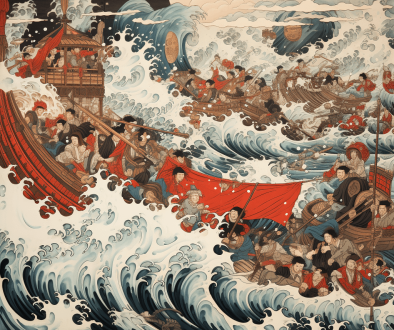Azuchi Momoyama
The period is known as Azuchi Momoyama (安土桃山時代) spans from 1573-1603. It is the last part of the Sengoku period, which intersected with the Muromachi period. This was a significant time in Japan, as the country drew for breath after the chaos and turmoil that had ensued after the collapse of the Ashikaga shogunate.

The order over the country was delivered by Oda Nobunaga, who was a samurai daimyo warlord. Then by his successor Toyotomi Hideyoshi, who would become the first ruler of the whole country since the Onin war. Although this was a short period, it was significant, as Japan made the transition from being in the medieval era, to what was known as the early modern era. There was great peace after the Battle of Sekigahara in 1600, and it would take another 3 years before Tokugawa Ieyasu could call himself shogun.

The period at this time took its name from 2 castles, one of which was Nobunaga’s Azuchi Castle, which was located in Shiga, and Hideyoshi’s Momoyama Castle, located in Kyoto.
What is Azuchi Momoyama japanese period?
The Azuchi-Momoyama period in Japanese history is a time of religious upheaval. It is a time when religious divisions that had been simmering beneath the surface of Japan for centuries came to a head. It is also a time when military tensions on the Korean Peninsula escalated and influenced events on the other side of the Sea of Japan.
It was named after two castles, Azuchi Castle and Momoyama Castle, which were built at the same time. The castle period was the result of the unification of Japan by Tokugawa Ieyasu, who became shōgun after unifying all of Japan except for Edo (Tokyo).
How Azuchi Momoyama Became the Fantastical Castle that it is Today?
The Azuchi Momoyama Castle was not the original castle of the Oda clan. It was built by Toyotomi Hideyoshi in the late 16th century after he destroyed the Odawara Castle.
Azuchi Momoyama Castle was not only the base of operations for Oda Nobunaga, but also for Tokugawa Ieyasu. It’s is still used today for tourism and weddings.
The Azuchi-Momoyama castle renovation project is an ambitious effort to preserve the architectural history of Japan. The project’s goal is to restore one of the country’s most important castles, Azuchi-Momoyama.
History of Azuchi Momoyama Period and How it Influenced Historic Japan
The Azuchi-Momoyama Period is the period in Japanese history where the warrior class (samurai) came into power. The samurai were driven by honor, loyalty, and the desire to be courageous in life and death.
The Azuchi-Momoyama Period can be seen as an era of great change. It is often said that this period was the last time Japan was united under one ruler before it became a feudal society. The three most important events during this time are 1) Oda Nobunaga’s conquest of Ise; 2) Toyotomi Hideyoshi’s campaign against Mōri Terumoto; 3) Tokugawa Ieyasu’s march on Kyoto to take on Toyotomi Hideyoshi.
Azuchi Momoyama Culture That Shaped Historic Japan’s Beauty
This period is noted for its distinctive architecture, the culmination of past styles mixed with elements that were new to Japan.
Azuchi Momoyama architecture can be seen in many castles, temples, and houses. One of the most famous castles is Osaka Castle. It was built between 1583-1598 by Toyotomi Hideyoshi.
The primary influences on Azuchi Momoyama architecture are Korean and Chinese architectural styles, which were imported to Japan via contact with traders from those countries.

How The Tradition of Red & White Influenced the Landscape of Kyoto Today
During this period, it became popular among the upper class to wear a red and white kimono design that features a striped pattern called ikat. This then led to the proliferation of this pattern in temples, shrines, and other buildings in Kyoto today.


